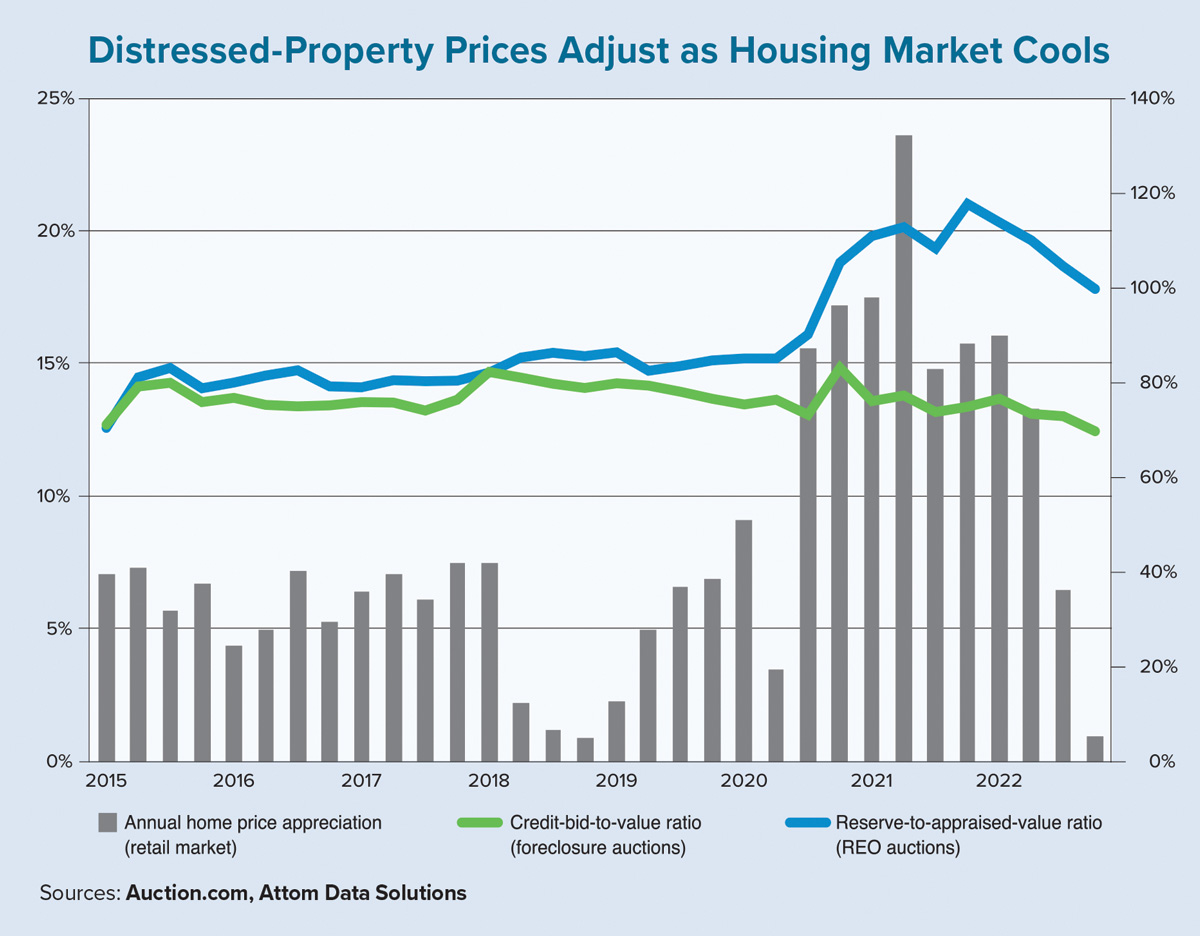Sellers of distressed property began to capitulate to the market on pricing in the fourth quarter of 2022, a positive sign moving forward for retail housing inventory. In particular, the final two months of last year saw some sellers at foreclosure auctions lower prices in response to the downshifting real estate market.
By the end of the year, national home prices declined by 9% from their peak in May 2022, with a deeper drop in some markets. Foreclosure-auction sellers who made proactive pricing adjustments experienced an immediate lift in sales performance, with the sales rates jumping by about 10 percentage points from October to December, according to Auction.com data. Sales price execution relative to estimated market value slipped by about 4 percentage points for these sellers, but that was roughly on par with the 3-point drop for sellers who did not proactively adjust their pricing, and the latter group did not benefit from a 10-point jump in the sales rate.
Partly as a response to rapidly weakening demand from distressed- property buyers, the average credit bid at foreclosure auction fell to 70% of the estimated as-is property value in Q4 2022. This 70% credit-bid-to-value ratio was down 3 percentage points from the previous quarter and down from 75% one year earlier, marking the lowest level on record for Auction.com data that goes back to first-quarter 2015.
The credit bid is similar to a traditional-auction reserve price and represents the lowest amount the seller is willing or able to accept in order to sell the property to a third-party buyer. The credit bid is capped at the maximum amount owed to the foreclosing entity, but that entity may choose to lower the credit bid if they are willing to accept less than what is owed. The as-is value represents the estimated value of the home in its current condition, based on an exterior evaluation of the home. An interior inspection is generally not possible prior to the foreclosure auction.
Credit-bid-to-value pricing at foreclosure auctions had previously jumped to a new record high of 83% in Q4 2020, shortly before the peak of the pandemic-triggered retail-market housing boom. Annualized price appreciation for existing home sales topped out at 24% in May 2021, according to Attom Data Solutions. This figure was the highest on record for data going back to 1997.
Similar (albeit slightly lagging) trends show up in Auction.com data for real estate-owned (REO) property auctions. At these auctions for bank-owned homes, the average reserve-to-appraised-value ratio dropped to 99.7% in Q4 2022, down from a post-pandemic peak of 117.7% in Q4 2021. Between 2015 and 2019, however, this ratio averaged 81.6%.
Following the lead of sellers at foreclosure auctions, sellers at REO auctions began to lower their reserve prices and even accepted more bids below this level. In turn, this will eventually help to return more previously distressed properties to the retail market. It also will help lenders avoid the risk associated with holding properties, a risk that is elevated in a market with declining values.
Higher-volume sellers, including those who sell properties at foreclosure and REO auctions, are often the first to respond to a downshift in the housing market. This is because of their ongoing and repeated sales activity, which provides them with better intelligence on real-time market conditions. It’s also due to risk aversion to REO holdings in a cooling market, making them more willing to downwardly adjust their pricing based on data rather than gut instinct.
Retail sellers typically follow the lead of institutional sellers in a slowing market. This bodes well for retail home sales volume in the 2023 spring and summer purchase seasons. As more distressed-property sellers respond to the downshifting market and lower their pricing, more pressure will be put on retail sellers to do the same. This will result in more well-priced homes listed for sale during this year’s prime home purchase periods. ●
Author
-

Daren Blomquist is vice president of market economics at Auction.com. In this role, Blomquist analyzes and forecasts complex macroeconomic and microeconomic data trends to provide value to both buyers and sellers using the platform. Blomquist has been cited by thousands of media outlets nationwide, including major news networks, The Wall Street Journal, The New York Times and USA Today. Prior to Auction.com, Blomquist worked at Attom Data Solutions.
View all posts







